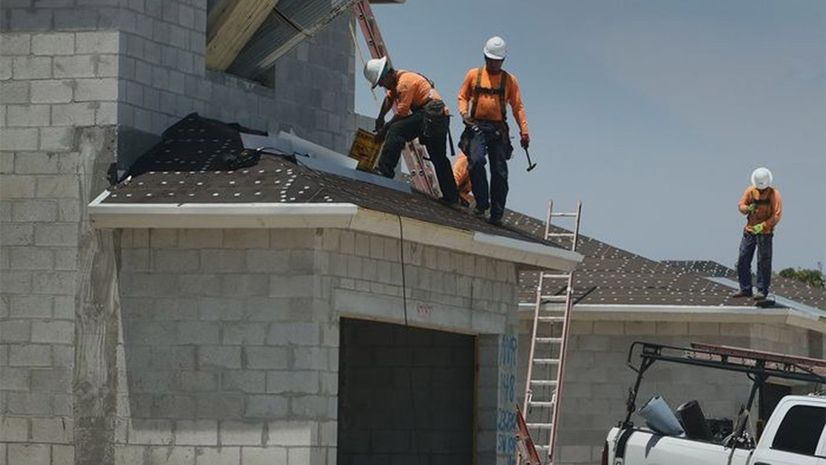The numbers: U.S. home builders started construction on homes at a seasonally-adjusted annual rate of roughly 1.7 million in December, representing a 1% increase from the previous month, the U.S. Census Bureau reported Wednesday. Compared with December 2020, housing starts were up 2.5%.
Meanwhile, permitting for new homes occurred at a seasonally-adjusted annual rate of 1.87 million, up 9% from November and 6.5% from a year ago.
Economists polled by MarketWatch had expected housing starts to occur at a median pace of 1.65 million and building permits to come in at a median pace of 1.71 million.
Key details: The surge in permitting was driven by a 112% increase in the number of housing structures authorized in the Northeast. The Census Bureau explained the anomaly in a special notice with the housing-starts report: Philadelphia ushered in multiple changes to real-estate taxes for residential projects that are permitted after Dec. 31. Therefore, developers rushed to get permits approved ahead of that start date.
Still, the Northeast wasn’t the only region to see building permits increase. Permitting activity also rose nearly 22% in the Midwest on a monthly basis, though it fell in both the South and the West.
Most of the boost in permitting activity stemmed from a swathe of authorizations for multifamily buildings and projects with between two and four housing units. Before seasonal adjustments, the number of multifamily permits issued in December was the highest for any month since 1985. Single-family permits only increased 2% between November and December.
Similarly, the number of single-family homes that builders started construction on actually dropped by roughly 2% on a monthly basis. The overall increase in housing starts was driven by a nearly 14% gain in construction on multifamily projects.
For the full year, though, builders maintained a steady pace of construction on single-family properties. Before seasonal adjustments, the number of single-family homes completed in 2021 was the highest since 2007.
The big picture: December’s surge in housing permits may be an outlier, but permitting activity has remained strong in recent months. That’s created a larger backlog of construction projects for home builders, as construction firms continue to grapple with shortages of both supplies and labor.
Indeed, the number of housing units that construction companies haven’t started work on despite having the authorization to begin building is up 44% from a year ago and rose on a monthly basis. This will give builders plenty of runway to continue construction work in 2022, which should infuse the housing market with much-needed inventory.
At the current level, the number of housing units under construction—including both single-family homes and multifamily buildings—remains “at a level last seen in 1973,” said Richard Moody, chief economist at Regions Financial Corp., in a note. “For each single family unit completed in December there were 9.5 single family units under construction, the highest ratio in the life of the data,” he added.
Investors soon will get even more granular data on home-construction activity, providing a richer look at the state of the housing market. The Census Bureau noted that starting with the January 2022 housing-starts report, it will use a different sampling methodology to produce its findings. The agency said the change will “allow complete local and county data on new housing units authorized by permits to be published on a monthly basis going forward.”
Looking ahead: “Momentum could cool this year as interest rates rise, we still expect homebuilding to stay at healthy levels as builders make progress on backlogs. Homebuilders’ confidence hit a 10-month high in December, while building permits, a good proxy for future home construction, remain elevated,” Robert Kavcic, senior economist at BMO Capital Markets, wrote in a research note.
“Low inventories should continue to support building activity, but shortages—of inputs and labor—remain constraints for now,” wrote Rubeela Farooqi, chief U.S. economist at High Frequency Economics in a research note.
“Multi-family building, which lagged notably in the early stages of the pandemic, is now the dominant driver of the strength,” Jeffries chief economist Aneta Markowska and money market economist Thomas Simons wrote in a research note. “This is likely a response to surging rents and ultra-low rental vacancy rates.”
“New home inventory is now more than three times higher, relative to sales, than inventory of existing homes, the biggest gap ever, by far. This position is likely to persist for several more months, at least, but homebuilders also will be closely watching how people respond to rising mortgage rates; a further surge in new home construction at this point looks risky to us,” said Ian Shepherdson, chief economist at Pantheon Macroeconomics.
Market reaction: The S&P 500 Index and the Dow Jones Industrial Average rose slightly in Wednesday morning trades, as investors sifted through the last batch of bank earnings. Equities have fallen in recent days amid expectations that the Federal Reserve will hike interest rates soon.
Home-builder stocks—including Lennar Corp., Toll Brothers Inc., D.R. Horton Inc. and PulteGroup Inc.—were a mixed bag Wednesday morning. These stocks fell Tuesday after the latest edition of the confidence index from the National Association of Home Builders pointed to weakening optimism in the construction sector.

